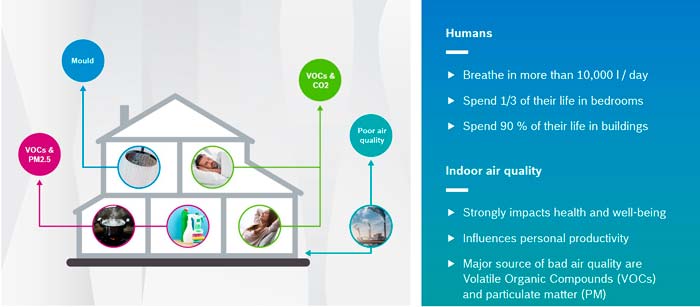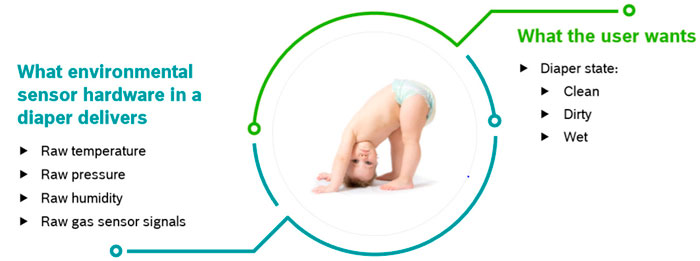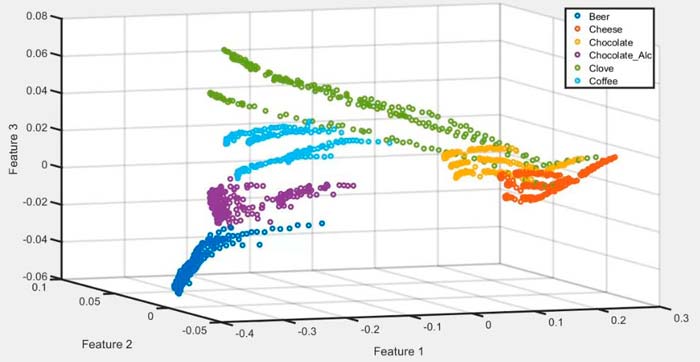 It is all around us, but unless there is a problem, we usually do not concern ourselves with what is in the air that we breathe. In both indoor and outdoor environments, poor air quality can greatly impact our health and well-being. Two important indicators for air pollution measurement are small particulate matters (PM) of 2.5 microns or less (PM2.5) and volatile organic compounds (VOCs). They are, for example, emitted in households by fireplaces and candles during combustion processes. Everyday objects such as cleaning supplies, furniture, or textiles can also emit VOCs. This article provides insights into new PM2.5 and VOC sensing technologies that enable personal air quality monitoring to improve people’s health and well-being.
It is all around us, but unless there is a problem, we usually do not concern ourselves with what is in the air that we breathe. In both indoor and outdoor environments, poor air quality can greatly impact our health and well-being. Two important indicators for air pollution measurement are small particulate matters (PM) of 2.5 microns or less (PM2.5) and volatile organic compounds (VOCs). They are, for example, emitted in households by fireplaces and candles during combustion processes. Everyday objects such as cleaning supplies, furniture, or textiles can also emit VOCs. This article provides insights into new PM2.5 and VOC sensing technologies that enable personal air quality monitoring to improve people’s health and well-being.
Personal PM2.5 monitoring
We know that exposure to particulate matter can cause serious health problems, and the World Health Organization (WHO) says, “By reducing air pollution levels, countries can reduce the burden of disease from stroke, heart disease, lung cancer, and both chronic and acute respiratory diseases, including asthma[i].”
While particulate matter comes in a vast range of particle sizes, the biggest impact to human health is from particulates in the PM2.5 range[ii], which are smaller than 2.5 µm (microns) in diameter. These minute PM2.5 particulates can easily enter deep into the lungs and cause serious health problems. Although research is still ongoing, there is evidence that PM2.5 exposure can be linked to sensitivity to viral diseases, including SARS-CoV-2, as discussed in a recent study by Harvard University[iii].
Official air quality monitoring stations provide only consolidated or averaged data for the outdoor environment without the corresponding indoor air data. They do not generate personalized information and only measure air quality in their immediate vicinity that is averaged-out over a time period, and thus lack real-time information for tracking the rapidly-changing environment around us and for monitoring the fluctuations in local PM levels.
A portable air quality measuring device or dosimeter for air pollution measurement – for example, in our smartphones or wearables – could solve this problem. Until now, PM2.5 sensors have simply been too large for mobile devices. Bosch Sensortec has recently developed a sensor technology that can now make the monitoring of personal exposure to air pollution a viable reality.
With the new Bosch PM2.5 technology, it is now possible to integrate PM2.5 sensing into mobile devices for measuring a person’s daily exposure to PM. The user can be shown data and trends on the local pollution levels that they are being exposed to. Monitoring the personal exposure to air pollution, e.g. with the smartphone, allows users to get reliable and transparent information, which enables them to take action and minimize their PM2.5 exposure according to WHO air quality guidelines[iv]. This can help to improve people’s health and well-being.
For example Figure 1 shows a PM2.5 Dosimeter demonstration App that was created in collaboration with the company BreezoMeter. The Dosimeter App calculates personal daily PM exposure by combining PM data locally measured with the Bosch PM 2.5 sensor technology and BreezoMeter air pollution data.
Tiny particulate sensor technology
Conventional optical consumer PM sensors rely on a built-in fan to draw air through a cell, where the particulate count is registered and the concentration per unit of volume is calculated. The problem with this approach is the sheer physical size of such a sensor, typically around the size of a matchbox, making it impractical for use in a flat portable device, like a smartphone.
The unique PM sensor technology recently developed by Bosch Sensortec only needs natural ambient air flow to function. It is based on a camera-like principle, where three Class 1 eye-safe lasers are integrated behind a glass cover, in a similar way to the cameras in a smartphone.
This novel approach enables Bosch Sensortec to develop a PM sensing solution with dramatically smaller physical dimensions, taking up approximately one five-hundredth (0.2 %) of the volume of other solutions on the market. This reduction to the size of a match head makes this new technology ideal for personal PM2.5 measurement in consumer devices. It has low power consumption, is maintenance-free and can be integrated into a waterproof application.
Detecting VOCs
Another airborne source of concern is presented by volatile organic compounds (VOCs), which is a pretty large group of chemically reactive gases that can appear in any room. With people typically spending 90% of their life indoors, the concentration of VOCs in ambient indoor air can significantly impact our well-being and health.
A VOC sensor can detect a wide range of gases both inside buildings and outdoors, such as (hydro-) carbon compounds (e.g. alcohol or CO), sulphide compounds (causing unpleasant smells, e.g. H2S), and solvents (e.g. acetone). They come, for example, from paint, lacquers or detergents. In a smart home, VOC information helps to control multiple devices, such as turning a kitchen hood on and off, or starting an air purifier. Additionally, it can be used to generate alerts, for example by detecting a fire, or even spoiled food in a refrigerator. VOC data can also be used with other Internet of Things (IoT) applications, for example optimizing ventilation in an office building based on air quality.
To measure VOCs, Bosch has developed a compact, high performance gas sensor. The BME680 is the world’s smallest solution that provides 4-in-1 air quality monitoring. It can measure ambient temperature, barometric pressure, relative humidity and gases and is housed in a 3 x 3 x 0.93 mm3 package. It works in the ultra-low power range down to less than 0.1 mA.
The sensor is able to distinguish between fresh air (i.e. clean air, mainly nitrogen, oxygen and humidity) and used air with additional pollutants. Typically, when people are present in rooms, the exhaled breath is one of the most important reasons for poor air quality. Knowing the amount of exhaled air contained in ambient air helps to optimize ventilation, and thereby helps to prevent airborne transmission of infections like SARS-CoV-2[v]. Although VOC sensors cannot directly detect viruses, they indirectly contribute to people’s health and wellbeing.
Intelligent software turns the collected sensor data into useful outputs for the users. By combing modern gas sensing techniques with artificial intelligence (AI), different ambient conditions can now be recognized and classified, which enables many new applications.
Let’s consider an advanced example of risk evaluation for forest climate mapping and early wildfire detection. Firstly, a sensor network maps out the entire area with a real-time view of all environmental activities. Secondly, machine learning is used to create a mathematical model based on raw data for classifying and predicting different situations and assessing risk. And lastly, edge AI is used to adapt the final product to the area-specific conditions of the individual user and to lower power consumption.
Another application could be detecting when a baby’s diaper needs changing. The sensor hardware can measure temperature, pressure, humidity and the presence of gases – but the parents do not want this level of detail, they just need to know when action is required. As about 19 % of the population over the age of 20 suffer from smell disorders, this “basic” information can help them to regain some quality of life[vi]. A mathematical model, developed with machine learning, can be used to translate the raw sensor data into a simple status indication, with AI fine-tuning the model in operation.
Bosch is further extending the gas sensor’s range to add new capabilities and to enable new use cases. New gas sensing technologies will include more sophisticated software and a wider range of gas detection capabilities. For example, the gas sensor could detect different gas compositions – which, when compared with reference data, would enable smells to be identified (Figure 5). Examples of use cases could be monitoring of the cleanliness status of public spaces, classification of bad breath or detection of spoiled food.
Conclusions
By generating accurate, real-time, personalized air quality data, these new sensor technologies will change how we assess the quality of the air around us and enable us to respond accordingly. We will better plan when to be outdoors to adapt our commuting or sports activities. We will manage the air quality inside our homes by controlling ventilation and avoiding particle generation. When adapted on a broader scale, this will also help us to make informed decisions, for example when relocating to a new area or when deciding where to go on vacation. With the increasing awareness to keep the environment and ourselves healthy, the demand for air quality applications will continue to grow in the future.
Bosch air quality sensing technologies are small enough to be used in flat portable devices such as smartphones and low-cost enough for broad adoption – which will deliver noticeable benefits to both the individual and society as a whole.
By Alexander Herrmann, Project Director Optical Sensing Business, and Dr. Richard Fix, Product Portfolio Manager, Bosch Sensortec
References
[i] WHO, ‘Ambient (outdoor) air pollution’, https://www.who.int/news-room/fact-sheets/detail/ambient-(outdoor)-air-quality-and-health
[ii] Department for Environment Food & Rural Affairs, Public Health: ‘Sources and Effects of PM2.5’, https://laqm.defra.gov.uk/public-health/pm25.html
[iii] Harvard University, ‘Linking Air Pollution to Higher Coronavirus Death Rates’, https://www.hsph.harvard.edu/biostatistics/2020/04/linking-air-pollution-to-higher-coronavirus-death-rates/
[iv] https://www.who.int/news-room/fact-sheets/detail/ambient-(outdoor)-air-quality-and-health
[v] Environment international: “Airborne transmission of SARS-CoV-2: The world should face the reality”, 2020, https://www.sciencedirect.com/science/article/pii/S016041202031254X
[vi] Harvard Medical School: “Smell disorders: When your sense of smell goes astray”, 2018, https://www.health.harvard.edu/blog/smell-disorders-when-your-sense-of-smell-goes-astray-2018121215539







